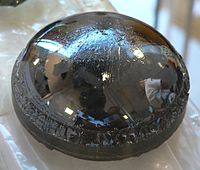
Photo from wikipedia
Considerable efforts have been made to manufacture composite materials with low density and to enhance the specific strength of metals and alloys by adding boron carbide particles. One of the… Click to show full abstract
Considerable efforts have been made to manufacture composite materials with low density and to enhance the specific strength of metals and alloys by adding boron carbide particles. One of the major factors in enhancing the mechanical properties of these composites is the interfacial characteristics of the metal/ceramic interface, particularly the strength of the bonding between the metal/ceramic interface. Here we investigate the microstructure and interfacial characteristics of the boron carbide-nickel (B4C-Ni) and silicon carbide-boron carbide (SiC-B4C) composites processed in the solid state at relatively high pressure, using transmission electron microscopy. The sintered boron carbide and nickel powders showed improved hardness and modulus, which is attributed to the formation of nickel boride (Ni4B3) at the nickel-boron carbide interface. Using fine-probe energy dispersive spectroscopy and high-angle annular dark field imaging, we observed a Si-rich intermixing layer for the silicon carbide-boron carbide interface, which could enhance the strength of the interface. The density functional theory calculations show that the decohesion energy of silicon carbide-boron carbide (without intermixing) is smallest at the interface as compared with the bulk silicon carbide and boron carbide, and that the structure would fail along the interface.
Journal Title: JOM
Year Published: 2020
Link to full text (if available)
Share on Social Media: Sign Up to like & get
recommendations!